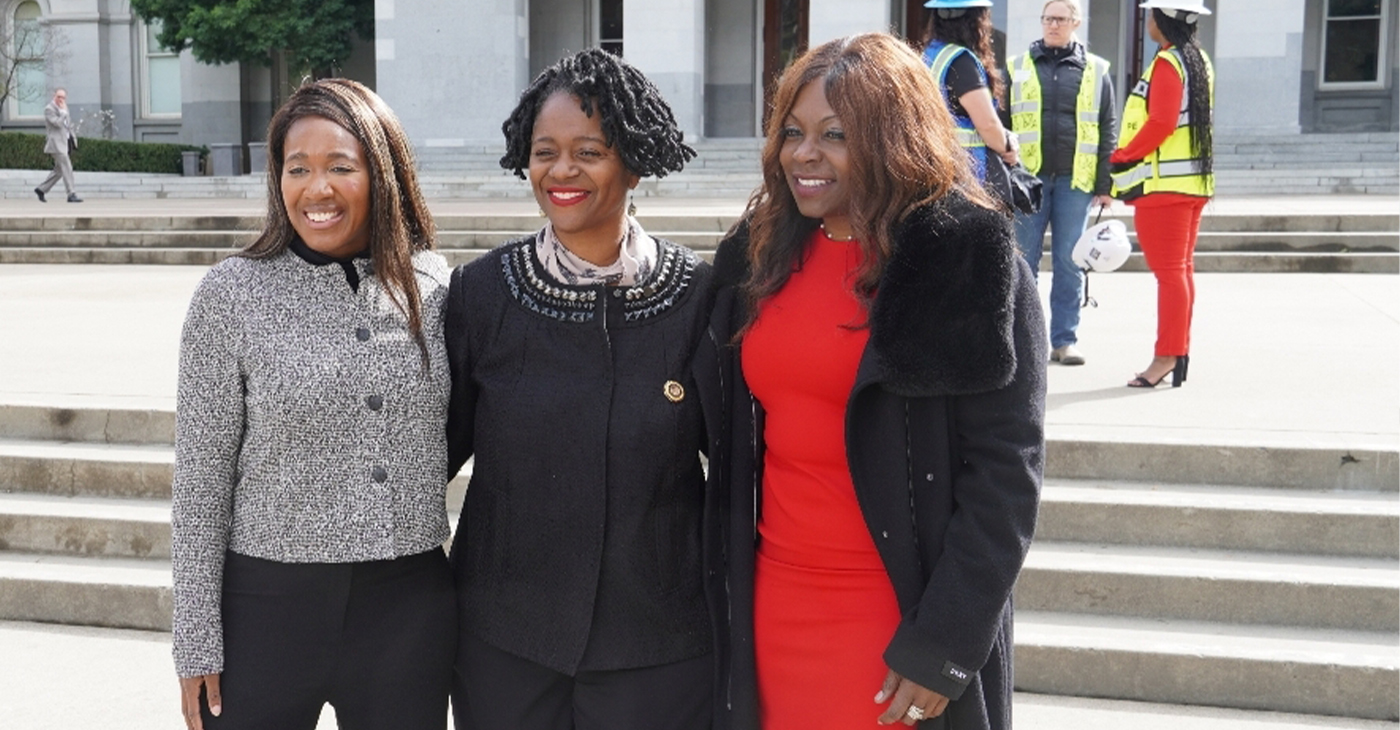Politics
Obama’s Record Budget: Tax the Rich, Help Middle Class

ANDREW TAYLOR, Associated Press
WASHINGTON (AP) — Promising to help America’s middle class, President Barack Obama on Monday sent Congress a record $4 trillion budget that would hammer corporate profits overseas and raise taxes on the wealthy while boosting tax credits for families and the working poor.
Obama’s budget also would steer hundreds of billions of dollars to the nation’s crumbling infrastructure of roads and bridges, help provide two years of free community college and reverse the across-the-board, automatic budget cuts that have slammed the Pentagon and nearly every government department.
In the face of certain opposition from Republicans, an optimistic Obama hailed a “breakthrough year for America” of new jobs, lower unemployment and shrinking deficits after the great recession of 2008, and he called for moving past years of “mindless austerity.” The blueprint for the 2016 budget year that begins Oct. 1 represents a 6.4 percent increase over estimated spending this year, projecting that the deficit will decline to $474 billion.
However, Obama’s plan ignores the new balance of power in Washington, with Republicans running both the House and Senate. The GOP found plenty to criticize in his proposed tax hikes that would total about $1.5 trillion.
Republicans cited the nation’s $18 trillion debt and assailed what they call Obama’s tax-and-spend policies for failing to address the spiraling growth of benefit programs such as Social Security and Medicare.
“Today President Obama laid out a plan for more taxes, more spending, and more of the Washington gridlock that has failed middle class families,” said House Speaker John Boehner, R-Ohio. “This plan never balances — ever.”
Republicans aren’t offering specifics yet but will respond this spring with their own plan, a balanced-budget outline promising to get rid of “Obamacare,” ease the burdens of the national debt on future generations, curb the explosive growth of expensive benefit programs and reform a loophole-cluttered tax code in hopes of promoting economic growth.
While Obama’s plan was rejected out of hand on budget day, proposals to ease automatic cuts and boost transportation funding are likely to return later in the year and require extensive negotiation.
“These proposals are practical, not partisan,” Obama said of his overall plans. “They’ll help working families feel more secure with paychecks that go further, help American workers upgrade their skills so they can compete for higher-paying jobs, and help create the conditions for our businesses to keep generating good new jobs for our workers to fill.”
Some people would pay more. Many wealthy Americans would only be able to take tax deductions at a 28 percent rate even though their incomes were taxed at 39.6 percent, and some would also see an increase in their maximum capital gains rate.
However, a couple earning up to $120,000 a year would qualify for a new “second earner” tax credit of up to $500 as well as a maximum $3,000 per-child tax credit for child care for up to two children, triple the current credit of $1,000.
Obama’s initiatives to tax the wealthy and to welcome an influx of immigrants into the United States are going nowhere in the new GOP-run Congress.
But there is a bipartisan desire to ease automatic spending cuts that are the product of Washington’s failures to cut deficits beyond an initial round in 2011. Both Republicans and Democrats are howling that such broad cuts savage the Pentagon. Obama said he won’t give more money to the Pentagon without receiving domestic funds he wants.
“It would be bad for our security and bad for our growth,” Obama said Monday at the Department of Homeland Security.
The centerpiece of the president’s tax plan is an increase in the capital gains rate on couples making more than $500,000 per year. The rate would climb from 24.2 percent to the Reagan-era top rate of 28 percent. Obama also wants to require estates to pay capital gains taxes that reflect the increase in value of assets like homes and stocks prior to death instead of after inheritance. And he is trying to impose a 0.07 percent fee on the roughly 100 U.S. financial companies with assets of more than $50 billion, raising $112 billion over 10 years.
All told, Obama proposes higher receipts of about $2 trillion though his budget: about $1.5 trillion from tax increases and almost $500 billion from fresh revenue as immigration reform lifts the economy and provides new workers.
His proposals would boost federal spending by $74 billion — divided between the military and domestic programs — and would result in a spending increase of $362 billion over the remaining six years the spending caps were to have been in place.
The deficit would remain under $500 billion a year through 2018, but would rise to $687 billion by 2025, according to administration projections — though levels of red ink could still be considered manageable when measured against the size of the economy.
But the cost of financing the government’s debt would spiral as the debt grows to more than $25 trillion by 2025 and interest rates rise. According to the projections. Interest costs would jump from $229 billion this year to $785 billion in 2025.
A principal theme this year is infrastructure — the budget books’ cover photo is the deteriorating Tappan Zee bridge over the Hudson River — and the plan includes a six-year, $478 billion transportation and infrastructure plan. Gasoline tax revenues would cover only half the cost, so Obama proposes a 14 percent tax on overseas corporate profits to bring in $238 billion. The combination would permit about a one-third increase in spending, with transit programs being the biggest winners.
Obama’s plan contains a lengthy roster of proposals that have been repeatedly rejected by lawmakers: $600 billion in additional revenue over a decade by limiting tax deductions for upper bracket earners; $95 billion from nearly doubling the cigarette tax to $1.95 a pack, and $35 billion through a minimum 30 percent tax rate on million-dollar incomes.
He wants to increase the security fee paid on air travel from $5.60 to $7.50 per one-way ticket. And there’s a new 10-year, $2.5 billion proposal to limit the deductibility of gifts that boosters of college teams give to earn the right to buy basketball and football tickets.
The White House claims $1.8 trillion in deficit savings over 10 years but does so by taking liberties such as ignoring the cost of preventing Medicare cuts to doctors’ fees and extending refundable tax credits for the working poor and couples with children that expire in 2017.
___
Associated Press writers Martin Crutsinger and Jim Kuhnhenn contributed to this report.
Copyright 2015 The Associated Press. All rights reserved. This material may not be published, broadcast, rewritten or redistributed.
Activism
Oakland Post: Week of March 28 – April 1, 2025
The printed Weekly Edition of the Oakland Post: Week of March 28 – April 1, 2025

To enlarge your view of this issue, use the slider, magnifying glass icon or full page icon in the lower right corner of the browser window.
Activism
Sen. Lola Smallwood-Cuevas Honors California Women in Construction with State Proclamation, Policy Ideas
“Women play an important role in building our communities, yet they remain vastly underrepresented in the construction industry,” Smallwood-Cuevas stated. “This resolution not only recognizes their incredible contributions but also the need to break barriers — like gender discrimination.

By Antonio Ray Harvey, California Black Media
To honor Women in Construction Week, Sen. Lola Smallwood-Cuevas (D-Los Angeles), a member of the California Legislative Black Caucus (CLBC), introduced Senate Concurrent Resolution (SCR) 30 in the State Legislature on March 6. This resolution pays tribute to women and highlights their contributions to the building industry.
The measure designates March 2, 2025, to March 8, 2025, as Women in Construction Week in California. It passed 34-0 on the Senate floor.
“Women play an important role in building our communities, yet they remain vastly underrepresented in the construction industry,” Smallwood-Cuevas stated. “This resolution not only recognizes their incredible contributions but also the need to break barriers — like gender discrimination.
Authored by Assemblymember Liz Ortega (D-San Leandro), another bill, Assembly Concurrent Resolution (ACR) 28, also recognized women in the construction industry.
The resolution advanced out of the Assembly Committee on Rules with a 10-0 vote.
The weeklong event coincides with the National Association of Women In Construction (NAWIC) celebration that started in 1998 and has grown and expanded every year since.
The same week in front of the State Capitol, Smallwood, Lt. Gov. Eleni Kounalakis, Assemblymember Josh Hoover (R-Folsom), and Assemblymember Maggie Krell (D-Sacramento), attended a brunch organized by a local chapter of NAWIC.
Two of the guest speakers were Dr. Giovanna Brasfield, CEO of Los Angeles-based Brasfield and Associates, and Jennifer Todd, President and Founder of LMS General Contractors.
Todd is the youngest Black woman to receive a California’s Contractors State License Board (A) General Engineering license. An advocate for women of different backgrounds, Todd she said she has been a woman in construction for the last 16 years despite going through some trying times.
A graduate of Arizona State University’s’ Sandra Day O’Connor College of Law, in 2009 Todd created an apprenticeship training program, A Greener Tomorrow, designed toward the advancement of unemployed and underemployed people of color.
“I always say, ‘I love an industry that doesn’t love me back,’” Todd said. “Being young, female and minority, I am often in spaces where people don’t look like me, they don’t reflect my values, they don’t reflect my experiences, and I so persevere in spite of it all.”
According to the U.S. Bureau of Labor Statistics, only 11.2% of the construction workforce across the country are female. Overall, 87.3% of the female construction workers are White, 35.1% are Latinas, 2.1% are Asians, and 6.5% are Black women, the report reveals.
The National Association of Home Builders reported that as of 2022, the states with the largest number of women working in construction were Texas (137,000), California (135,000) and Florida (119,000). The three states alone represent 30% of all women employed in the industry.
Sen. Susan Rubio (D-Baldwin Park) and the California Legislative Women’s Caucus supported Smallwood-Cuevas’ SCR 30 and requested that more energy be poured into bringing awareness to the severe gender gap in the construction field.
“The construction trade are a proven path to a solid career. and we have an ongoing shortage, and this is a time for us to do better breaking down the barriers to help the people get into this sector,” Rubio said.
Bay Area
Five Years After COVID-19 Began, a Struggling Child Care Workforce Faces New Threats
Five years ago, as COVID-19 lockdowns and school closures began, most early educators continued to work in person, risking their own health and that of their families. “Early educators were called essential, but they weren’t provided with the personal protective equipment they needed to stay safe,” said CSCCE Executive Director Lea Austin. “There were no special shopping hours or ways for them to access safety materials in those early and scary months of the pandemic, leaving them to compete with other shoppers. One state even advised them to wear trash bags if they couldn’t find PPE.”

UC Berkeley News
In the first eight months of the COVID-19 pandemic alone, 166,000 childcare jobs were lost across the nation. Significant recovery didn’t begin until the advent of American Rescue Plan Act (ARPA) Child Care Stabilization funds in April 2021.
Today, child care employment is back to slightly above pre-pandemic levels, but job growth has remained sluggish at 1.4% since ARPA funding allocations ended in October 2023, according to analysis by the Center for the Study of Child Care Employment (CSCCE) at UC Berkeley. In the last six months, childcare employment has hovered around 1.1 million.
Yet more than two million American parents report job changes due to problems accessing child care. Why does the childcare sector continue to face a workforce crisis that has predated the pandemic? Inadequate compensation drives high turnover rates and workforce shortages that predate the pandemic. Early childhood educators are skilled professionals; many have more than 15 years of experience and a college degree, but their compensation does not reflect their expertise. The national median hourly wage is $13.07, and only a small proportion of early educators receive benefits.
And now a new round of challenges is about to hit childcare. The low wages paid in early care and education result in 43% of early educator families depending on at least one public support program, such as Medicaid or food stamps, both of which are threatened by potential federal funding cuts. Job numbers will likely fall as many early childhood educators need to find jobs with healthcare benefits or better pay.
In addition, one in five child care workers are immigrants, and executive orders driving deportation and ICE raids will further devastate the entire early care and education system. These stresses are part of the historical lack of respect the workforce faces, despite all they contribute to children, families, and the economy.
Five years ago, as COVID-19 lockdowns and school closures began, most early educators continued to work in person, risking their own health and that of their families. “Early educators were called essential, but they weren’t provided with the personal protective equipment they needed to stay safe,” said CSCCE Executive Director Lea Austin. “There were no special shopping hours or ways for them to access safety materials in those early and scary months of the pandemic, leaving them to compete with other shoppers. One state even advised them to wear trash bags if they couldn’t find PPE.”
The economic impact was equally dire. Even as many providers tried to remain open to ensure their financial security, the combination of higher costs to meet safety protocols and lower revenue from fewer children enrolled led to job losses, increased debt, and program closures.
Eventually, the federal government responded with historic short-term investments through ARPA, which stabilized childcare programs. These funds provided money to increase pay or provide financial relief to early educators to improve their income and well-being. The childcare sector began to slowly recover. Larger job gains were made in 2022 and 2023, and as of November 2023, national job numbers had slightly surpassed pre-pandemic levels, though state and metro areas continued to fluctuate.
Many states have continued to support the workforce after ARPA funding expired in late 2024. In Maine, a salary supplement initiative has provided monthly stipends of $240-$540 to educators working in licensed home- or center-based care, based on education and experience, making it one of the nation’s leaders in its support of early educators. Early educators say the program has enabled them to raise wages, which has improved staff retention. Yet now, Governor Janet Mills is considering cutting the stipend program in half.
“History shows that once an emergency is perceived to have passed, public funding that supports the early care and education workforce is pulled,” says Austin. “You can’t build a stable childcare workforce and system without consistent public investment and respect for all that early educators contribute.”
The Center for the Study of Childcare Employment is the source of this story.
-

 #NNPA BlackPress4 weeks ago
#NNPA BlackPress4 weeks agoTarget Takes a Hit: $12.4 Billion Wiped Out as Boycotts Grow
-

 Activism4 weeks ago
Activism4 weeks agoUndocumented Workers Are Struggling to Feed Themselves. Slashed Budgets and New Immigration Policies Bring Fresh Challenges
-

 Activism4 weeks ago
Activism4 weeks agoOakland Post: Week of February 26 – March 4, 2025
-

 #NNPA BlackPress4 weeks ago
#NNPA BlackPress4 weeks agoBREAKING Groundbreaking Singer Angie Stone Dies in Car Accident at 63
-

 #NNPA BlackPress4 weeks ago
#NNPA BlackPress4 weeks agoNAACP Legend and Freedom Fighter Hazel Dukes Passes
-

 Arts and Culture4 weeks ago
Arts and Culture4 weeks agoBeverly Lorraine Greene: A Pioneering Architect and Symbol of Possibility and Progress
-

 #NNPA BlackPress4 weeks ago
#NNPA BlackPress4 weeks agoTrump Kicks the Ukrainian President Out of the White House
-

 #NNPA BlackPress4 weeks ago
#NNPA BlackPress4 weeks agoApple Shareholders Reject Effort to Dismantle DEI Initiatives, Approve $500 Billion U.S. Investment Plan

























































